All you ever wanted to know about Watercolor Granulation
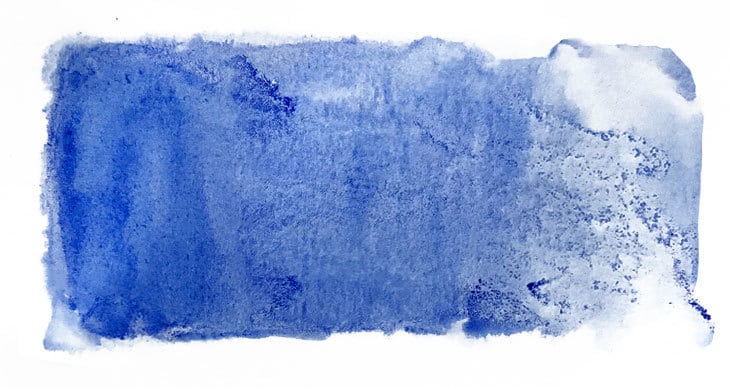
Have you ever noticed how watercolor paints behave differently ? Some colors produce a smooth even wash, but others seem to have a life of their own, creating amazing textured patterns.
When you play around with watercolors for a while you’ll soon notice this interesting aspect of watercolor painting.
Don’t worry, there’s nothing wrong with your paint !
One of the most beautiful characteristics of watercolor is the surprising textures it can produce. And granulation is one of the traits that adds incredible texture.
You’ve probably heard watercolor artists discussing granulating paints (sometimes referred to as flocculating or sedimentary watercolors).
But what is a granulating watercolor ?
Watercolor granulation results from the type of pigments used in the paint formula. Some pigments tend to cluster together creating uneven mottled washes. Granulating watercolors produce delicate textures because of the characteristics of their pigment particles.
Personally I like the expressiveness produced by this effect. The subtle textures created by granulation is something unique to watercolors !
Some watercolor artists prefer smooth even colors and do all they can to avoid granulating paints. Others exploit this effect to produce beautiful dappled effects in their artwork.
Whatever your preference, this is a characteristic worth getting to know !
Granulating pigments
Pigments are the basis of the color appearance in our watercolors.
In the past, artists used organic substances to provide pigments for their paint. These natural pigments are the origin of some of the poetic paint “names” we recognize today, (names such as Alizarin, Sepia, Gamboge etc.).
Today the majority of pigments used in paint are man made(known as synthetic organic pigments).
Many synthetic organic pigments form clumps during manufacturing. These clumps can be broken down by milling before the pigments are made into paints, but not all pigments are equally as easy to grind. As a result the size and shape of pigments varies slightly from one paint to another.
As a general rule, small fine pigment particles will produce less granulation, and these watercolors produce a flat and smooth painted surface.
Larger, heavier, irregularly sized pigments will cause more granulation and these can bring about some wonderful mottled textured effects.
Obviously, given the vast range of different paints, the size and shape of pigments is changeable from one tube of paint to the next. As a result the degree of granulation differs quite a bit.
Granulation on watercolor paper
When you lay down a wet watercolor wash, at first the color pigments are suspended in the water of the fluid paint. As the water evaporates, the pigments settle onto the paper. Granulating pigments are heavier than non-granulating pigments, and so they sink into the paper under the influence of gravity.
The mottled textures of granulation can be observed on all types of watercolor paper. On smooth hot-pressed paper the pigments tend to do as they please and move around randomly until all the water evaporates. On cold-pressed or rough watercolor paper the dispersion of pigments is slightly more even, and the pigments tend to fall into the low crevices and valleys of the rough paper surface.
Remember, you can vary your choice of paper according to the effect you’re trying to achieve.
Which watercolors granulate ?
As you’ve probably gathered by now, whether or not your watercolors granulate depends very much on the type of pigments which comprise the paint. But the brand and grade of paint can also influence the amount of granulation, since the formula varies a lot between manufacturers.
You will also find that cheaper, student grade watercolors will granulate less because their paint formula tends to contain less pigment (pigments are expensive, so lower quality paint uses less of them).
But generally speaking, certain colored pigments have more sedimentary qualities than others.
For example, finding red and yellow hues that granulate is really hard. Whereas blues and purples, have a good range of granulating colors.
Below is a list of some common granulating watercolors (non exhaustive).
Granulating blues
Finding blue sedimentary colors is pretty easy. A lot of the generic paint names of artist quality paint use the same pigment in their paint formula, but it is worth checking to be sure.
French Ultramarine is probably one of the most commonly used warm blues and is very granulating. Ultramarine Blue falls into the same category.

Prussian Blue also tends to granulate quite a bit.
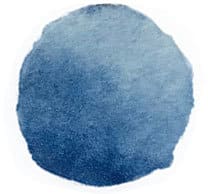
Cerulean Blue and Lapis Lazuli are medium-light hued blues which granulate well.

A medium and warm hued blue would be Cobalt Blue.
Granulating red and yellows
Granulating reds and yellows are pretty rare. The only one which seems to come close is Perylene Scarlet which is a medium semi-transparent paint.
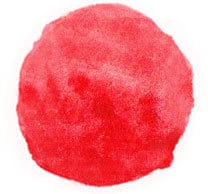
About the only way to get granulation in reds, is by using the Granulation Medium (see below). It takes some experimentation, but you can achieve some dramatic granulating texture effects this way.
Depending on the kind of red you need, you can also try mixing a non-granulating red with another granulating color such as purple or an earth hues. Colors such as Cobalt Violet, Ultramarine Red (actually a purple hue) or Burgundy Red Ochre and Quinacridone Burnt Orange could do the job.
Yellows are similarly difficult to find. Again the only yellow hue I know of is Nickel Titanate Yellow which is a light hue and does not really granulate a lot.
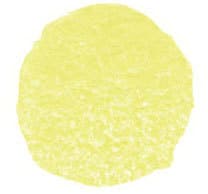
If you’re mixing a more neutral yellow you could try French Ochre or Yellow Ochre. Also Buff titanium mixed with a non-granulating yellow paint may do the trick !
Granulating earth tones
Earthy browns are also among the paint colors which have good granulating properties. Some of my favorites include Raw Sienna, Burnt Sienna and Burnt Umber.



Granulating black watercolor
You can find some quite good black watercolor sedimentary paints. Payne’s Gray and Ivory Black granulate. But the most dramatic granulating black I’ve found is Hematite Genuine from the Primatek series by Daniel Smith.
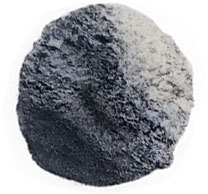
List of Daniel Smith granulating watercolors
Like a lot of artists, I’m a fan of Daniel Smith watercolors. They have a huge range of colors to choose from and have a particularly good choice of granulating paints. At the time of writing I counted 111 granulating paints in their “Extra Fine Watercolor” range.
That’s a huge choice !
Here they are:
Buff Titanium
Nickel Titanate
Perylene Scarlet
Mayan Red
Opera-Pink
Potter’s Pink
Mayan Violet
Cobalt Violet
Cobalt Violet Deep
Ultramarine Red
Rose of Ultramarine
Imperial Purple
Purpurite Genuine
Ultramarine Violet
Amethyst Genuine
Cobalt Blue Violet
Moonglow
Shadow Violet
Sugilite Genuine
Kyanite Genuine
Sodalite Genuine
Lapis Lazuli Genuine
Ultramarine Blue
French Ultramarine
Cobalt Blue
Lavender
Verditer Blue
Prussian Blue
Mayan Blue Genuine
Cerulean Blue
Cerulean Blue Chromium
Manganese Blue Hue
Cobalt Teal Blue
Kingman Green Turquoise Genuine
Ultramarine Turquoise
Sleeping Beauty Turquoise Genuine
Cobalt Turquoise
Blue Apatite Genuine
Lunar Blue
Cobalt Green Pale
Viridian
Diopside Genuine
Cascade Green
Jadeite Genuine
Cobalt Green
Sap Green
Serpentine Genuine
Chromium Green Oxide
Green Apatite Genuine
Terre Verte
Prussian Green
Rare Green Earth
Undersea Green
Zoisite Genuine
Olive Green
Bronzite Genuine
Verona Gold Ochre
Burnt Bronzite Genuine
French Ochre
Burgundy Yellow Ochre
Yellow Ochre
Mars Yellow
Yavapai Genuine
Raw Sienna
Transparent Yellow Oxide
Monte Amiata Natural Sienna
Enviro-Friendly Yellow Iron Oxide
Goethite – Brown Ochre
Italian Deep Ochre
Lunar Earth
Burnt Yellow Ochre
Garnet Genuine
Roasted French Ochre
Burgundy Red Ochre
Indian Red
Venetian Red
Italian Burnt Sienna
Quinacridone Burnt Orange
Quinacridone Sienna
Pompeii Red
Red Fuchsite Genuine
Terre Ercolano
Minnesota Pipestone Genuine
Italian Venetian Red
English Red Earth
Hematite Burnt Scarlet Genuine
Sedona Genuine (Natural Iron Oxide)
Lunar Red Rock
Piemontite Genuine
Tiger’s Eye Genuine
Burnt Tiger’s Eye Genuine
Hematite Genuine
German Greenish Raw Umber
Hematite Violet Genuine
Mummy Bauxite (Natural Iron Oxides)
Quinacridone Gold
Raw Umber Violet
Transparent Brown Oxide
Transparent Red Oxide
Fired Gold Ochre
Enviro-Friendly Red Iron Oxide
Burnt Sienna
English Red Ochre
Burnt Umber
Enviro-Friendy Brown Iron Oxide
Raw Umber
Sepia
Sicklerite Genuine
Van Dyck Brown
Bloodstone Genuine
Lunar Violet
Payne’s Gray
Black Tourmaline Genuine
Ivory Black
Lunar Black
This list does not include the Daniel Smith Primatek series which contains an additional 32 interesting granulating watercolors.
Watercolor granulation medium
Some of you may be wondering how to make your watercolors granulate even if they aren’t sedimentary ?
To achieve the textured effect of granulation you can use granulation medium.
This is a liquid solution which you can add to your watercolors, either by diluting your tube paints directly with the medium, or by mixing on the paper, by brushing medium onto fresh washes.
The most dramatic result are obtained by using this neat from the bottle. You might find the results too strong.
Instead you can try laying down a very, thin wash of a granulating medium first then put on washes of color layered on top of the granulation medium. This usually retains the granulating effect without sacrificing the color you want or producing excessive textures.
Take care when using granulation medium not to mix it with your normal palette, or you may end up contaminating all your colors with granulating fluid. The best idea is probably to keep your color mixing separate when you want to use this product.
This product also seems to increase the drying time of your paintings, so you’ll need to be patient!
How to get granulation effects with watercolor
So how do you make your watercolors granulate.
Personally I get the impression that granulation is better on cold press or rough paper, and also it shows more if the paper is dampened. I often brush a little water on the paper, then add the watercolor mixed with more water. This allows the particles to float until the heavier particles clump and do their thing on the paper.
One method to force granulation is to add a lot of water to your pigment, then go back and charge your wash with more pigment.
Another tip is to keep your paper flat and horizontal. If your paper is tilted the pigments run downward under gravity and the granulation effect is lost.
Often, when you get backruns and blooms the granulation effect is even more exaggerated.
If you don’t have many sedimentary watercolors and as an alternative to granulating medium, my best advice is to try creating your own textures. Try splattering water onto your paint using a hard bristled brush or a spray bottle filled with water. You can also scatter salt or rice onto your paint, although I would be careful with salt in time the paper will degrade,
Just get some scrap paper and give it a try !
Are your watercolors granulating ?
Why not check you own colors to see which ones granulate !
Depending on which brand of paint you use, identifying which of your watercolor paints have granulating characteristics is more or less simple. Sometimes you’ll find this kind of information on the labels of the paint tubes. Alternatively you can download the color chart of your chosen brand where you’ll find all the properties of each paint. Here for example is what this looks like on the Daniel Smith watercolor chart:
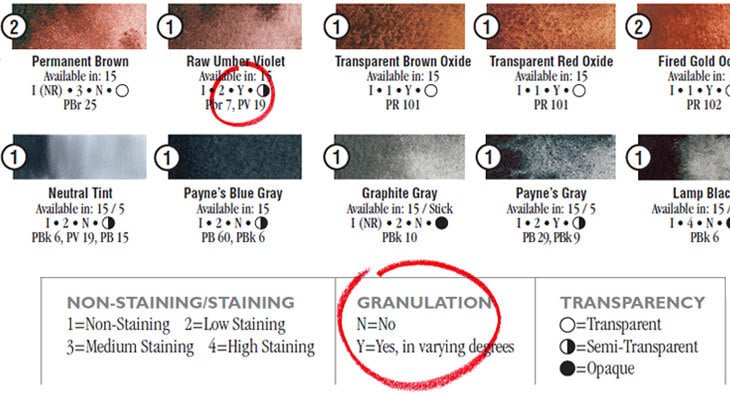
The granulation element is generally indicated Yes or No (Y or N). Some brands such as M. Graham use a “G” to indicate granulation.
You can download their color chart here…
The same for Schmincke whose color chart you’ll find here…
For Winsor & Newton, finding this information is slightly tricky. You have to consult the individual paints on their website to find out whether they granulate: see this page …
For Sennelier, I wish you the best of luck – I couldn’t find this information anywhere !
If you can’t find this information for your own set of watercolors, you can use observation to help you determine their characteristics. If you examine your mixing palette after your paints have dried, you should be able to see clear granulation patterns from colors that are sedimentary. Try observing your palette occasionally to judge which of your colors fall into this category.
Conclusion
Granulating paints can be more difficult to control…
After all they seem to have a life of their own !
Beginners may find this kind of paint more of a challenge, but if you’re looking for amazing textures in your artwork, then it is certainly worth investing some time playing around with granulation…

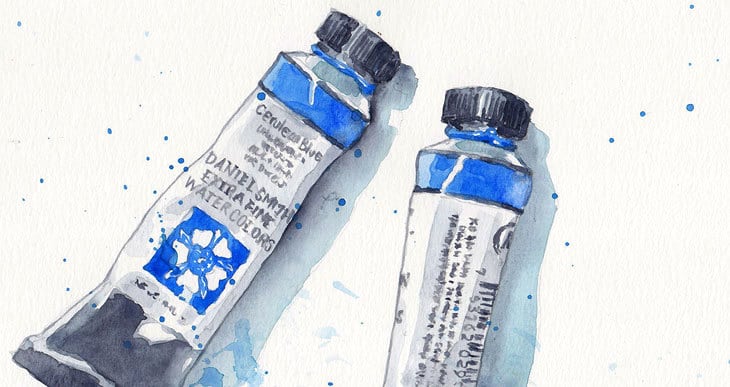
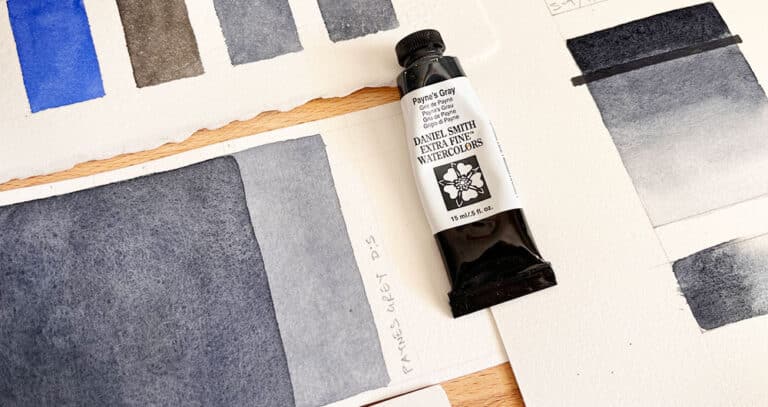
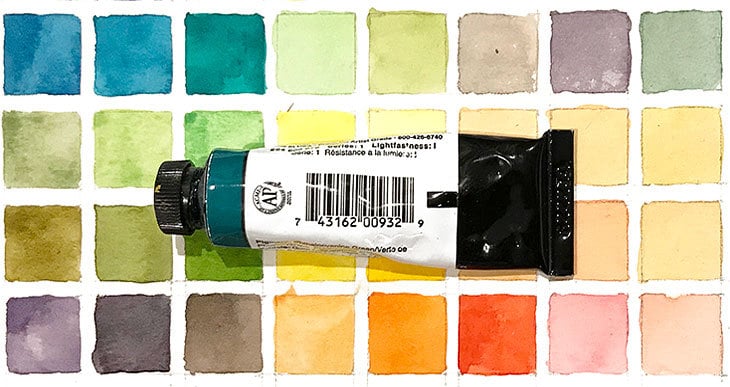


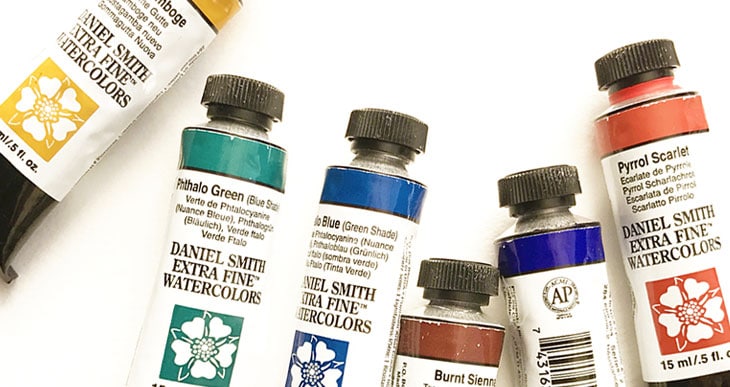
I want to add some yellow or light green colors to granulating blues. Is it better to under paint with yellow and then layer the granulating paint on top? Or is it better to put the granulating paint down first and then glaze over with the yellow?
Hi Marian
It depends on the effect your looking for. If you want the best granulation effect, I would suggest you mix the two colors together and let them settle onto the paper.
Lighter pigments in the yellows and greens will separate from the blues slightly as the paint dries, and the granulating blue pigments will do there thing and settle into the crevices of the paper.
Otherwise, when layering the paints as a glaze, the granulating blue wash will granulate on its own.
For a more pronounced granulating effect, make sure you use a very damp wash with plenty of water to allow the paint to settle as the water evaporates 🙂
Hope that helps!
Thankyou. Soo much information to share with my class. I’ll be saving
This info for reference.
Thank you, a really informative lesson in granulation.
I love the effects that can be achieved.
And will definitely experiment with my paints, a cheap brand unfortunately, I would love the Daniel Smith ones, perhaps as I improve I will purchase just a few colours, they look amazing.
Your article has inspired me.
Cheers Lin Waterhouse.
Thanks Lin
have fun with your paints !
Hi Anthony,
Many thanks for the explanation on how to apply water to see the best granulation. Tried it on some of the DS dots and it worked beautifully; previously I just painted them wet on dry and wondered what all the fuss was about.
Also very interesting to see the effects of mixing DS french ultramarine with practically any other color I already have on hand (some DS, some DV, some Blick’s) following this method. Opens up many avenues for play!
-Alf
Hi Alf
Yes granulation produces some amazing textures !
After my watercolor brushes have been cleaned and thoroughly dried, is it ok to store them vertically with the heads pointing up?
Hi Mattie
No, it’s best not to leave them upright because water can seep down into the ferrule (the metal part that holds the hairs) and this can loosen over time.
You can read this article if you need to know more :
https://www.watercoloraffair.com/how-to-clean-watercolor-brushes-the-easy-way/
Thank you for the useful article. I found it because I was looking for a way to *stop* cerulean blue granulating. I agree with you that it produces lovely effects, and useful for some applications. But the sky I want is clear and blue and certainly not granulated.
Can you recommend a Daniel Smith sky blue that won’t granulate – or tell me how to achieve the beautiful Cerulean Blue Chromium colour of the sky without the unwanted hugely granulated effect?
I don’t mind a bit of granulation, but it is so granulated the whole sky looks like the scales of a fish!
Hi Jane
I agree with you about Daniel Smith’s Cerulean blue. Nowadays I prefer Cobalt blue for skies – it’s much smoother and doesn’t have the same granulation as Cerulean.
Thanks for all the granulating info!
It was very helpful and presented in a easy-to-follow format
No problem Denise – glad it was useful
Enjoyable and you have certainly read a great deal and put a lot of work into this.
Hi Colin. Thanks for the comment ! Hope the article helps…